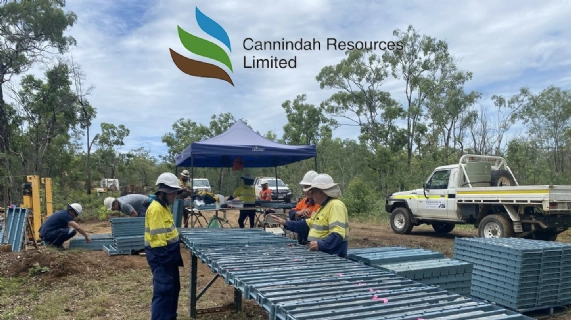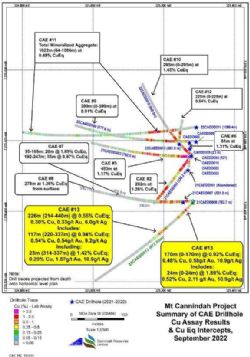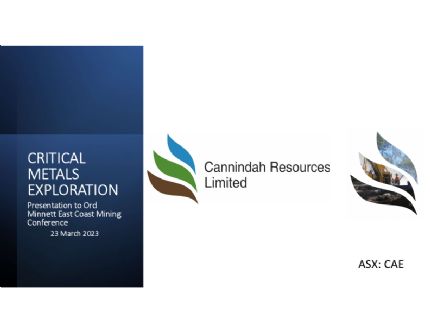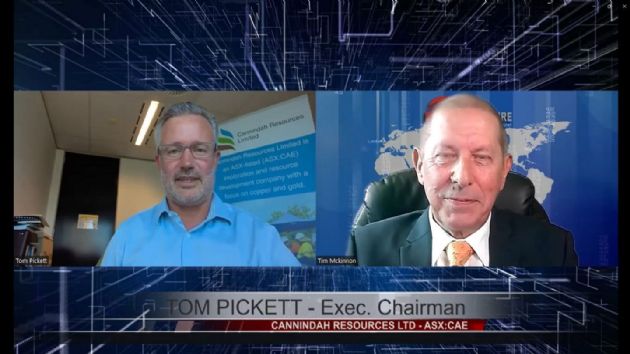
Wide Cu-Au Intervals Extend Mt Cannindah Resource
Brisbane, Sep 30, 2022 AEST (ABN Newswire) - Cannindah Resources Limited ( ASX:CAE) is pleased to announce the next set of completed assay results from the drilling program currently underway at Mt Cannindah, copper gold silver project south of Gladstone near Monto in central Queensland (Figs 1 to 3*) pertaining to hole 22CAEDD013 (final depth 672.5m).
ASX:CAE) is pleased to announce the next set of completed assay results from the drilling program currently underway at Mt Cannindah, copper gold silver project south of Gladstone near Monto in central Queensland (Figs 1 to 3*) pertaining to hole 22CAEDD013 (final depth 672.5m).
Highlights: -
- UPPER BRECCIA ZONE 104m @ 1.0% CuEq*. Including highgrade 16m zone @ 2.32% CuEq
- SURFACE GOLD ZONE 0-24m @ 2.11 g/t Au
- LOWER BRECCIA ZONE 108m @ 1.01% CuEq
- DEEPER GOLD ZONE 15m @ 2.78 g/t Au (314m-329m)
- Mineralisation in the lower breccia has similarities with the upper zones of major porphyry systems found throughout the SW Pacific as discussed below
- Hole 13 has extended the existing resource area and also created a great deal of exploration upside for the Mt Cannindah project in the south-west.
EXECUTIVE CHAIRMAN COMMENTS
"Hole 13 set out to explore extensions of copper and gold mineralisation to the south-west at Mt Cannindah. It achieved everything we had hoped to achieve and more with hundreds of metres of high-grade copper intercepts along with an excellent 24m gold hit from surface. The veining and alteration seen in the lower sections of the Mt Cannindah breccia to the southwest point to similarities with large scale porphyry systems which we will be further investigating. The hole extends the mineralisation to the south-west improving the size of the project and opens up a larger exploration area. It's clear we have already outlined a significant area of excellent grade copper, gold and silver in the breccia zone. Now we can also seek to establish what vectors are present that point, either at depth or peripheral to the Mt Cannindah breccia, towards a major Cu-Au-Ag mineralised porphyry centre having potential for significantly more bulk tonnage."
CAE hole # 13 drilled to the south-west (magnetic azimuth 211 degrees). It was planned to determine whether continuity existed between the mineralised breccia drilled at the top of CAE hole # 8 and some patchy mineralised intersections located to the south, in scattered, wide spaced historic exploration holes drilling from west to east. CAE's drilling is designed to obtain better data on copper, gold and silver grades, while testing the general geometry and extent of geological units such as breccias and mineralised structures. If CAE was able to link known mineralisation with new intercepts from CAE hole 13, the new knowledge gained would create a great opportunity to expand the Mt Cannindah resource and understand the geological units to the south and south-west.
CAE holes in the southern zone of the Mt Cannindah breccia (CAE # 7, 8) were drilled from east to west (magnetic azimuth bearing 261 degrees) and returned thick intersections of high-grade copper-gold silver (Fig 4*), reported in previous CAE ASX announcements.
CAE hole 7: ASX announcement dated 21/2/2022:
- 75m of copper across two separate zones.
- 20m @ 1.19% Cu, 0.55g/t Au ,46g/t Ag from 95m to 115m, converts to 20m @ 1.89% Cu Eq.
- A lower zone of hydrothermal infill breccia in hole 7: 55m @ 0.77% Cu, 0.21g/t Au ,8.7g/t Ag from 192m to 247m, converts to 55m @ 0.97 % Cu Eq.
- Discovery, well below copper breccia of high-grade gold zone in hole 7 manifested by steep dipping semi-massive sulphide & quartz vein filled structure from 449m-452m in an overall 30m zone of elevated gold from 424m.
- Average of samples from 449m to 452m is 3m @ 28.67 g/t Au
- Most prominent sulphidic 1m section in hole 7, 450m to 451m returned 1m @ 81.6 g/t Au, 109.2 g/t Ag, 30.5% S.
CAE hole 8: ASX announcement dated 21/2/2022:
- Total mineralised intercept of infill breccia from hole 8 from surface is aggregated below, along with the various mineralised zones:
- 278m @ 0.87% Cu, 0.43 g/t Au, 16 g/t Ag (0m to 278m), this converts to 278m @ 1.26% Copper Equivalent (Cu Eq).
- Oxidised Breccia: 17m @ 0.23 % Cu, 1.09 g/t Au, 12.8 g/t Ag (0m to 17m) this converts to 17m @ 1.00 % Cu Eq
- Supergene zone: 2m @ 3.75% Cu, 1.4 g/t u, 19.7 g/t Ag (17m to 19m), this converts to 2m @ 4.78 % Cu Eq
- Near surface gold zone, primary hydrothermal breccia: 4m @ 0.3 % Cu, 1.53 g/t Au, 11.5 g/t Ag (28m to 32m), this converts to 4m @ 1.33 % Cu Eq
- Upper, high-grade chalcopyrite rich infill hydrothermal breccia: 43m @ 1.33 % Cu, 0.67 g/t Au, 29.8 g/t Ag (41m to 84m), this converts to 43m @ 1.98 % Cu Eq
- Thin quartz sulphide vein in clast supported breccia: 1m @ 8.18 g/t Au (478m-479m).
CAE holes # 7 & 8 have drilled down the long axis and demonstrably across the layering of the Mt Cannindah breccia body (refer CAE ASX Announcement: 21 February 2022).
The overall geological interpretation built up from CAE holes 7 & 8 and historical drilling is of a steeply west dipping, roughly north south oriented, tabular body of breccia, bounded on the east by hornfels and on the west by diorite and wedges of hornfels. After drilling holes 7 & 8, interpretation of the southern section of the breccia deposit, at around 300m RL, an apparent transition was noted from chalcopyrite rich hydrothermal infill breccia to a pyritic clast supported breccia with variable, but often lower amounts of chalcopyrite. The boundary between the hydrothermal infill breccia and the clast supported breccia appears deeper in the northern section of the breccia deposit, suggesting a northerly plunge for this contact. Bleached, altered, diorite porphyries and post mineral andesite dykes cut the clast supported breccia.
Geological observations from oriented drill core from CAE holes, indicate that there is often a general gentle easterly dip to the slabs/clasts within the hydrothermal breccia. This essentially means that, far from drilling down dip, the CAE holes drilling from the east have in fact been often drilling at right angles to the structural grain of the breccia. Structural information was also obtained from the gold bearing, sulphidic structure intersected at 450m in hole #7. This steep structure strikes at 140 degrees magnetic and is likely to cut the pathway of hole # 13.
CAE hole # 13 is collared very close (within 1m or so) of CAE hole #8. The azimuth of CAE #13 is 211 degrees magnetic, i.e., making a difference in drill direction between the trace of hole # 7 & 8 and hole # 13 of 50 degrees (magnetic). The traces of the CAE holes are projected in plan view in Fig 4*.
*To view tables and figures, please visit:
https://abnnewswire.net/lnk/F99W7R32
About Cannindah Resources Limited
 Cannindah Resources Limited is an ASX-listed (ASX:CAE) Queensland, Australia-based exploration and resource development company. We are focused on copper and gold mineral exploration, evaluation, and progressing various mineral projects.
Cannindah Resources Limited is an ASX-listed (ASX:CAE) Queensland, Australia-based exploration and resource development company. We are focused on copper and gold mineral exploration, evaluation, and progressing various mineral projects.
Cannindah's goal is to preserve shareholder wealth and grow the value of the flagship asset with prudent exploration methods. Our focus is to progress further exploration work at the Piccadilly Project and review the possible strategies for Mount Cannindah Project.
| ||
|









